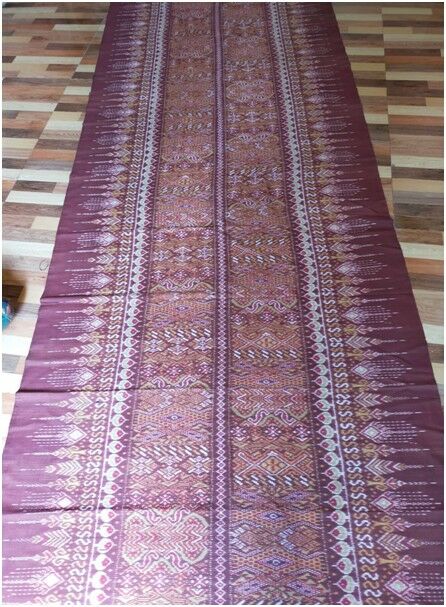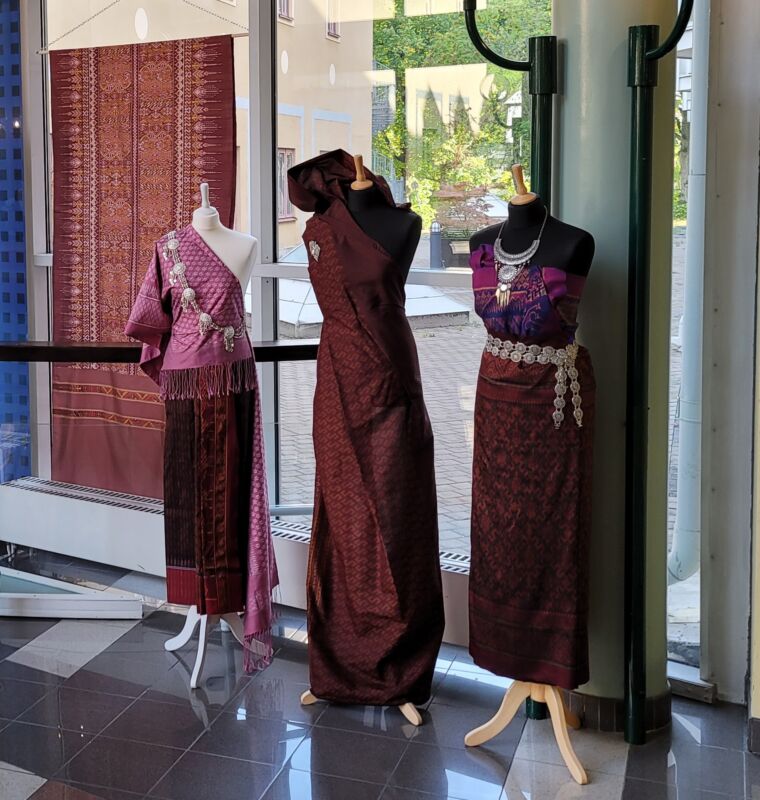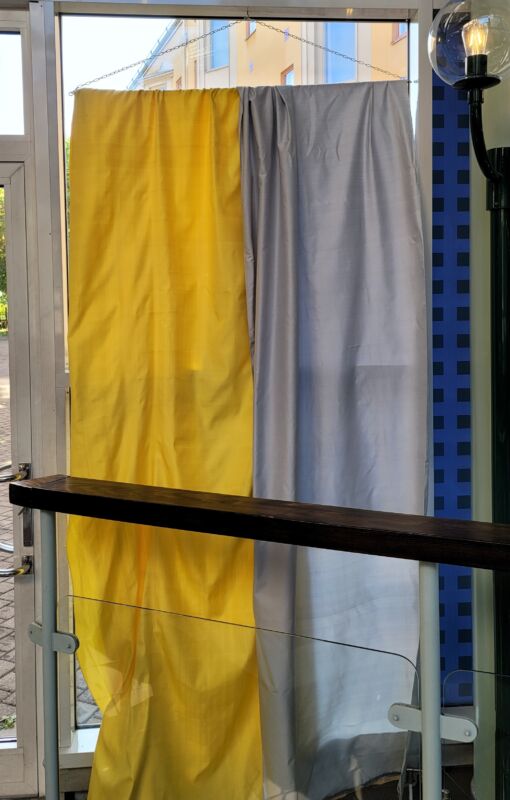North-East of Thailand

Silk dyed with 9 different auspicious materials
It is the natural-dyed lotus pattern silk which uses 9 auspicious materials including mud from a lotus pond of Sai Village (Basically it costs 50,000 – 80,000 Baht).
- Heartwood of jack tree – The owner will always have supporters.
- Heartwood of golden shower tree – The owner will prosper.
- Bark of star gooseberry tree – The owner will be admired.
- Bark of peltophorum dasyrrhachis tree – The owner will always be beautiful.
- Turmeric – No one insults and despises the owner.
- Ripe Tamarind – Everyone will care for the owner.
- Lac – The owner will have no worry about money.
- Mexican marigold flower – The owner will be promoted or grow business.
- Mud from lotus pond – The owner will be respected.

Middle Mannequin
Mudmee (Ikat) “Khor Chaofah Sirivannavari” pattern silk
It is woven by the 2-shaft loom at Khwaosinarin village, Khwaosinarin district in Surin Province. The warp yarn is tie-dyed to the “Anprom” (small checkered) pattern which is the traditional pattern of Surin province. The weft yarn is the royal pattern called “Khor Chaofah Sirivannavari.” The “S” pattern stands for Sirivannavari, Her Royal Highness Princess Sirivannavari Nariratana Rajakanya. The hearts at the edge stand for her royal highness princess’s eternal love for Thai people. It stimulates local communities to develop silk patterns and makes the Thai silk products modern and international for keeping their way of life sustainably.
Left Mannequin
Top: Turtle pattern silk dyed with lac
It is woven by the filament silk yarn called “mhai-noi” which is reeled from an inner part of silkworm cocoons. Its characteristic is smooth, soft and shiny. This pattern got cultural influence from Cambodia and was created with the story behind as the auspicious pattern. Natural dyed silk yarn is used for weaving, so its color is not flashy and has unique colors.
Skirt: It is the 41-lam (bundle) mudmee (ikat) silk woven by the 3-shaft loom with the lotus bud pattern at the top and bottom of the cloth. There is the 49-lam (bundle) cloth edge called “nanang.” Both weft and warp yarns are filament silk yarn from the golden silk. The phum khao bin is the name of the pattern which is similar to a phum khao bin (decorated tray with pedestal and sharp tip like lotus bud), a decorated tray with flowers or two-stacking decorated trays. The phum khao bin pattern appears in Thai architecture such as the chedis of the Sukhothai era, the top part of small open structure called “busabok” and so on.
Right Mannequin
Top: Mudmee (ikat) silk brocade with rhombus patterns woven by the 6-shaft loom (Name: Reverse hook)
It has tassels at the edge of the cloth called “Nanang.” The “Reverse hook” is the mudmee (ikat) silk brocade woven by the 6-shaft loom with rhombus patterns. The “reverse hook” is the auspicious pattern. We can wish for anything we want like money, good fortune and good health. To own this silk is auspicious. It will be with the owner forever and passed to children, then to grandchildren as their legacy. Silk is valuable like money because of the silk cloth and yarn making process. Silk is alive. Mulberry cultivation, silk farming, spinning, and weaving are hard and difficult. The joint part is dyed blue. The warp yarn is dyed blue as usual. There is dark brown color like tamarind seeds too. The difference is to add remarkable dimensions when it is under sunlight.
Skirt: Natural-dyed “hol” pattern silk
It is woven with 12 shuttles. The warp yarn is dyed with ebony fruits and soaked in mud. The top and bottom are red.
Red color is from the lac.
Yellow color is from the cockspur thorn.
Green color is from the garcinia dulcis.
Other colours are made by mixing natural materials based on local wisdom.
The hol cloth is the mudmeee (ikat) silk of Thai-Khmer ethnic group in Surin province and the symbolic pattern of Surin province’s mudmee silk cloths. The word “hol” in Khmer of Surin Province means a wrap around skirt that its weft yarn is tie-dyed and make patterns during the weaving process.

Yellow: Lamduan (white cheesewood) color silk (dyed with white cheesewood leaves)
It is the handwoven silk brocade dyed with petal, flower and bark of the white cheesewood tree. The white cheesewood is the provincial tree of Srisaket province which has pale yellow flowers with a fresh and good smell. There are more than 300,000 trees in Srisaket province. It is utilized to dye silk and cotton yarns to make natural-dyed cloths with beautiful and unique yellow, light yellow and dark brown colors.
Grey Blue: Si kula silk (dyed with soil from the “thung kula rong hai” area)
It is the handwoven silk brocade dyed with a soil from the “thung kula rong hai” area including Rasi Salai, Sila Lat, Yang Chum Noi, Kanthararom, Bueng Bun and Non Khun districts of Srisaket Province. This area is the premium hom mali (jasmine) rice production site. It is internationally recognized as the best rice variety. This “thung kula rong hai” soil is used for not only rice-planting but also dyeing silk and cotton yarns to make natural-dyed cloths with beautiful and unique grey color like the “thung kula rong hai” soil.
